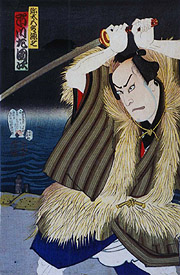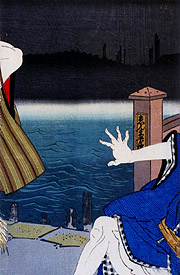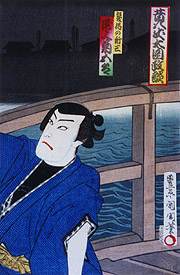| KAMIYUI SHINZA |
| Play title | Tsuyu Kosode Mukashi Hachijô |
| Author | Kawatake Shinshichi II |
| History |
The drama "Tsuyu Kosode Mukashi Hachijô" was premiered at the Nakamuraza in June 1873 [casting]. It was based on Shunkintei Ryûô III's popular narrative "Shirokoya Seidan", which was about the exploit of the magistrate Ôoka Echizen-no-Kami Tadasuke (1677~1751) to solve the Shirokoya case. Kawatake Shinshichi II was more interested in a crooked hairdresser than the upright magistrate. As a consequence, the scenes with Ôoka Echizen-no-Kami Tadasuke are rarely performed nowadays. |
| Structure |
The drama "Tsuyu Kosode Mukashi Hachijô" is made up of four acts and eleven scenes. 6 scenes are regularly performed nowadays. |
| Key words |
Bantô Eitaibashi Fukagawa Kamiyui Ôoka Seidan Ôoka-seidanmono Ôoka Tadasuke Sewamono Sumidagawa |
| Summary |
Act I scene 1: at the Shirokoya in the district of Zaimoku-chô The Shirokoya is a lumber-trading house managed by Otsune, who lost her husband. It was a prosperous business but the widow is not as successful as her late husband and the Shirokoya is about to go bankrupt. The only way to survive is to find a suitable husband for Otsune's daughter Okuma, who would take over the management and save the house. Zempachi, a friend of Otsune acting as a go-between, did his best to find the right man. It is an wealthy clerk named Kagaya Tôbê. Today is an important day because Tôbê arrives at the Shirokoya with many gifts for Otsune. Okuma, secretly in love with Chûshichi, the young Shirokoya's bantô, is not informed of this wedding arrangement. Otsune tearfully asks her daughter to accept it and the young girl can't refuse. She has of course a different plan in her mind. When Chûshichi comes back at the Shirokoya, Okuma implores him to run away together in order to commit a shinjû. Chûshichi knows that eloping with Okuma is a betrayal of the Shirokoya house. He deeply loves Okuma but can't take the decision right now. He sends her off in order to take the time to find a solution to this conflict between love and obligation. The hairdresser Shinza has overheard everything. He enters the house and easily persuades Chûshichi to have his hair done. Shinza, a strolling hairdresser from the district of Fukagawa Tomiyoshi, is absolutely not trustworthy. He knows how to play dirty tricks to gain some money. He convinces Chûshichi to follow the first part of Okuma's plan (the elopement). Then, if he prevents the girl from committing suicide, he would be the savior of Okuma's life and would be rewarded by Otsune. Chûshichi agrees to Shinza's plan and the hairdresser promises to take care of everything. Act I scene 2: near the Eitai Bridge It's dark and a few passers-by quickly run across the Eitai Bridge because of the falling rain. We can hear rolldrums from the geza, the classic sound effect for the flows of the Sumida River. A palanquin led by Katsu, the henchman of Shinza, appears on the hanamichi and quickly disappears on the bridge. As an evening temple bell rings in the distance, Shinza and Chûshichi appear on the hanamichi. Shinza walks fast and it is difficult for Chûshichi to take shelter under Shinza's umbrella. Chûshichi's wooden clog strap suddenly breaks and Shinza refuses to wait for him. Chûshichi, who has absolutely no idea where Shinza's home is, starts to understand that Shinza does not intend to take him there. Shinza abducted Okuma in order to get a ransom from the Shirokiya, not to help the clerk in his love affair. Shinza hits with his umbrella and pushes him out of the way roughly, before triumphantly disappearing in the dark. The festive music from the geza, which depicts the numerous yataibune flowing on the Sumida River, contrasts strongly with the dark mood of the deceived and hopeless Chûshichi. There is no option but suicide for him. He picks up a few rocks in order to make his body heavier and is about to jump in the water ... when Genshichi, a famous local boss, intervenes to save him. Act II scene 1: Shinza's Home in Fukagawa Okuma spent the whole night locked up in a closet. She cried all night and Shinza had to gag her. The scene opens in the morning, after Shinza has left his home to go to a bathhouse. Some inquisitive neighbours come to ask Katsu about the crying girl and he has some difficulty to find the appropriate answers. Shinza is back home and purchases an expensive bonito (katsuo in Japanese) to a colorful fishmonger. This fish will be cooked to celebrate the coming ransom for Okuma. Both Genshichi, the influential boss of the distric of Norimono-chô (the savior of Chûshichi) and Zempachi appear on the hanamichi. They come here to visit Shinza and negociate the liberation of Okuma. Shinza obsequiously welcomes them. Genshichi does not lose time in speech and quickly gives some money to Shinza. Shinza checks it and find a ridiculous amount of 10 ryô, which makes him angry. He takes out his anger on Genshichi, showering him with insults and scorn. The proud Genshichi manages to control his anger with difficulty and prefers to leave Shinza's home. Okaku, the wife of Shinza's landlord Chôbê, who has heard everything, accosts Genshichi and offers her services. She is sure that Chôbê will succeed in negociating with his tenant. Both Genshichi and Zempachi agree. The latter follows Okaku to Chôbê's home to discuss the details of the plan. Act II scene 2: at Shinza's landlord Chôbê's home Chôbê is a greedy and clever landlord. This Okuma affair is kiley to be a potential source of profit for him and he takes the time to think about it. He comes to the conclusion that 30 ryô should be enough to obtain the liberation of Okuma. Zempachi gives Chôbê the money and the Landlord gets ready to pay a visit to Shinza. Act II scene 3: back at Shinza's home Shinza is not really pleased to see Chôbê turn up at his place because he is always difficult to handle. The landlord notices the beautiful piece of bonito and has no difficulty to make Shinza promise half of the fish to him. They start their discussion with lots of mutual hypocritical compliments. Chôbê takes his time before broaching the Okuma affair. Shinza loses his temper when he finally realizes that Chôbê's offer is only 30 ryô. He expected at least 100 ryô. He starts to boast about his criminal record. He exhibits to Chôbê his infamous tattoos, made by the Edo jailers to their prisoners, in order to prove that he is not a small-time crook. This is the mistake which Chôbê has been waiting for. He raises his voice and says that he can't rent his house to a criminal and is about to go to report Shinza to the Police. The hairdresser understands that he lost the negotiations and begs Chôbê to stay, agreeing to free immediately Okuma for 30 ryô. Zempachi, who had been listening in, quickly takes Okuma back home in a palanquin. It is payment time. The restless Shinza is irritated by the slowness of crafty old Chôbê, who slowly counts each piece and puts them one by one in front of Shinza, stopping at fifteen and saying that half the fish is for him. Shinza does not understand the meaning of this sentence. Chôbê restarts the counting of the pieces several times. Katsu is the first to finally get the meaning of this "half the fish" and explains it to his master. Shinza is upset but in no position to protest. Chôbê can pocket the money, taking the opportunity to take 2 extra pieces as the rent of the house and leaving only 13 pieces to the defeated Shinza. A neighbor suddenly comes running to tell them that Chôbê's home has been burgled. Okaku faints while Chôbê rushes back home, not forgetting to take half of the bonito. This burglary is a kind of consolation for Shinza. Act III scene 1: near the Enmadô bridge The scene opens a few months later near the Enmadô bridge. Genshichi appears and asks a noodle-seller to leave the place. He does not want any witness around and, once alone, lurks in the dark. Genshichi was ready to forget the humiliation he suffered at Shinza's home but the hairdresser kept on boasting about it all over town. The boss of Norimono-chô can't stand it any longer. Tonight, he plans to kill him. Shinza and Katsu appear, coming from a gambling house. They are in good mood because they were in luck and made gains tonight. Katsu goes on an errand for his master and Shinza is alone when Genshichi suddenly appears to confront him. There is a short tachimawari but Shinza's killing is not shown on stage. It is a custom for the 2 actors to ceremoniously bow to the members of the audience, while the stage curtain is drawn to end the play. |
| Trivia |
It is custom for actors who are likely to play Shinza in a near future, to play first the role of Katsu. Only actors holding the name of Onoe Kikugorô are exempted from playing Katsu. |
 |
 |
 |
|
The actors Ichikawa Sadanji I and Onoe Kikugorô V playing the roles of Genshichi and Shinza in the drama "Tsuyu Kosode Mukashi Hachijô", which was staged in May 1893 at the Kabukiza (print made by Toyohara Kunichika) |
||
|
|
| Contact | Main | Top | Updates | Actors | Plays | Playwrights | Programs | Links | FAQ | Glossary | Chronology | Illustrations | Prints | Characters | Derivatives | Theaters | Coming soon | News |